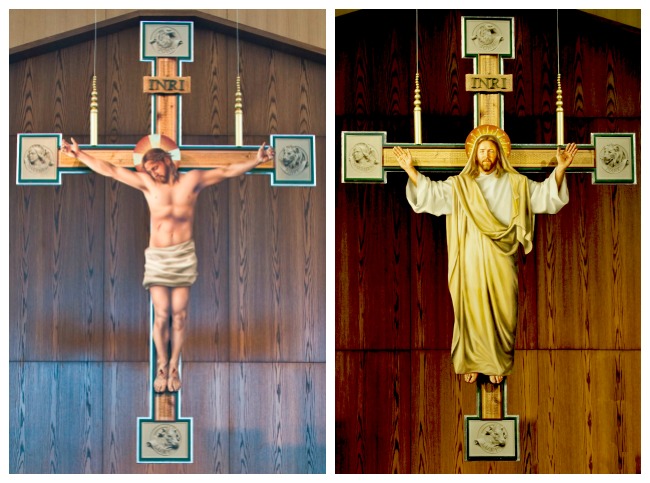Suspended directly over the altar is a cross, 12 feet by 8 feet. It goes by the Italian name croce dipinta, meaning a “painted cross.” This is a cross within a cross, a chiseled, tooled cross of cedar, framed by an outline of silver, gold, and copper leaf. The theology behind this symbolism says that our Lord used his cross but once, and after using it, made atonement for sins, and need not die again (Hebrews 10:12). Symbolically, therefore, the “old, rugged cross” is retired and decorated, a monument to what Jesus accomplished for all sinners.
To make this evident, the croce hangs directly over the altar, pointing at the mosaic of the slain Lamb and the words “Finished.”
The painted part of the cross consists of the corpus, or body, of Christ and the trompe l’oeil paintings of the four evangelists at the ends of the four arms of the cross. The evangelists appear in their fantastic symbolic images from Revelation 4: John the eagle, Mark the lion, Luke the ox, and Matthew the winged man. This arrangement serves notice how the gospel continues to go out into the world.
The croce displays two bodies of Christ, depending on the time of the church year. The one body, or corpus, shows Jesus as the High Priest, offering himself up in death. The other corpus shows him as Christ the King (Christus Rex).
Silver, gold, and copper leaf trace their ways on the front and sides of the cross. When approached from the main aisle, the croce is outlined by a brilliant silver reflection. But walk to the sides and watch the silver give way to gold and then to a coppery look. This allegory of colors says that the cross is always taking on a different light and look in the life of the Christian, because of the Christian’s age and circumstances.




